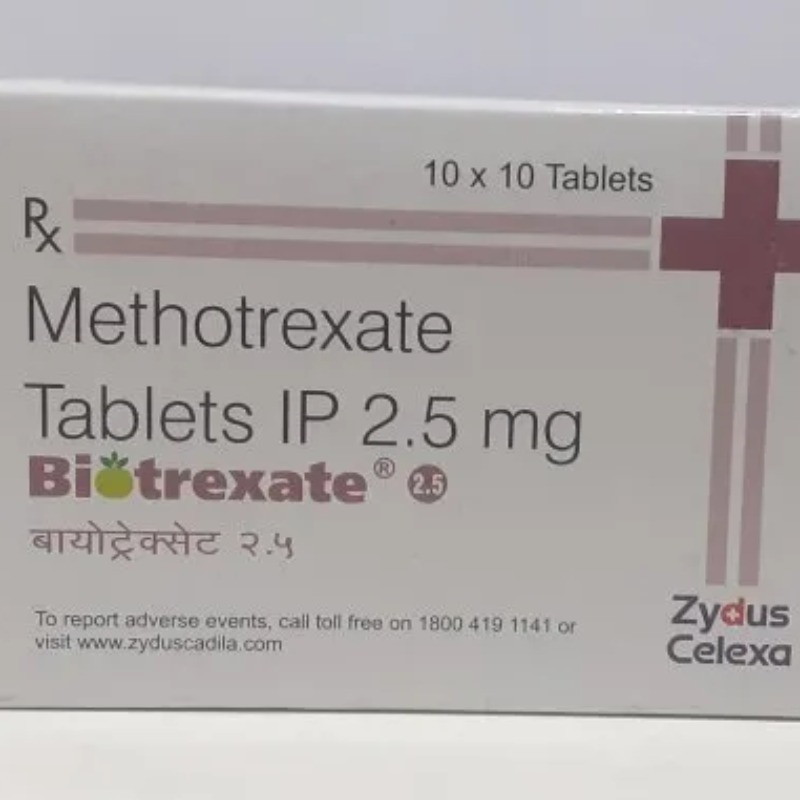DESCRIPTION
MECHANISM OF ACTION
• Cell cycle–specific antifolate analog, active in S-phase of the cell cycle.
• Enters cells through specific transport systems mediated by the reduced folate carrier (RFC) and the folate receptor protein (FRP).
• Requires polyglutamation by the enzyme folylpolyglutamate synthase (FPGS) for its cytotoxic activity.
• Inhibition of dihydrofolate reductase (DHFR), resulting in depletion of critical reduced folates.
• Inhibition of de novo thymidylate synthesis.
• Inhibition of de novo purine synthesis.
• Incorporation of dUTP into DNA, resulting in inhibition of DNA synthesis and function.
ABSORPTION
Oral bioavailability is saturable and erratic at doses greater than 25 mg/m2. Peak serum levels are achieved within 1–2 hours of oral administration. Methotrexate is completely absorbed from parenteral routes of administration, and peak serum concentrations are reached in 30–60 minutes after IM injection.
DISTRIBUTION
Widely distributed throughout the body. At conventional doses, CSF levels are only about 5%–10% of those in plasma. High-dose methotrexate yields therapeutic concentrations in the CSF. Distributes into third-space fluid
collections such as pleural effusion and ascites. Only about 50% of drug bound to plasma proteins, mainly to albumin.
INDICATIONS
1. Breast cancer.
2. Head and neck cancer.
3. Osteogenic sarcoma.
4. Acute lymphoblastic leukemia.
5. Non-Hodgkin’s lymphoma.
6. Primary CNS lymphoma.
7. Meningeal leukemia and carcinomatous meningitis.
8. Bladder cancer.
9. Gestational trophoblastic cancer.
DOSAGE RANGE
1. Low dose: 10–50 mg/m2 IV every 3–4 weeks.
2. Low dose weekly: 25 mg/m2 IV weekly.
3. Moderate dose: 100–500 mg/m2 IV every 2–3 weeks.
4. High dose: 1–12 g/m2 IV over a 3- to 24-hour period every 1–3 weeks.
5. Intrathecal: 10–15 mg IT two times weekly until CSF is clear, then weekly dose for 2–6 weeks, followed by monthly dose.
6. Intramuscular: 25 mg/m2 IM every 3 weeks.
DRUG INTERACTION 1
Aspirin, penicillins, probenecid, NSAIDs, and cephalosporins—These drugs inhibit the renal excretion of methotrexate, leading to increased plasma drug levels and potential increased toxicity.
DRUG INTERACTION 2
Warfarin—Methotrexate may enhance the anticoagulant effect of warfarin through competitive displacement from plasma proteins.
DRUG INTERACTION 3
5-FU—Methotrexate enhances the antitumor activity of 5-FU when given 24 hours before fluoropyrimidine treatment.
DRUG INTERACTION 4
Leucovorin—Leucovorin rescues the toxic effects of methotrexate but may also impair the antitumor activity. The active form of leucovorin is the L-isomer.
DRUG INTERACTION 5
Thymidine—Thymidine rescues the toxic effects of methotrexate and may also impair the antitumor activity.
DRUG INTERACTION 6
Folic acid supplements—These supplements may counteract the antitumor effects of methotrexate and should be discontinued while on therapy.
DRUG INTERACTION 7
Proton pump inhibitors—These agents may reduce the elimination of methotrexate, which can then result in increased serum methotrexate levels, leading to increased
toxicity. This is an especially important issue for patients receiving high-dose methotrexate.
DRUG INTERACTION 8
L-Asparaginase—L-Asparaginase antagonizes the antitumor activity of methotrexate.
SPECIAL CONSIDERATIONS
1. Use with caution in patients with abnormal renal function. Dose should be reduced in proportion to the creatinine clearance. Important to obtain baseline creatinine clearance and to monitor renal status during therapy.
2. Instruct patients to stop folic acid supplements during therapy, as they may negate the antitumor effects of methotrexate.
3. Monitor CBCs on a weekly basis and more frequently with high-dose therapy.
4. Use with caution in patients with third-space fluid collections such as pleural effusion and ascites, as the half-life of methotrexate is prolonged, leading to enhanced clinical toxicity. Fluid collections should be drained before methotrexate therapy.
5. Use with caution in patients with bladder cancer status post-cystectomy and ileal conduit diversion, as they are at increased risk for delayed elimination of methotrexate and subsequent toxicity.
6.With high-dose therapy, methotrexate doses > 1 g/m2, important to vigorously hydrate the patient with 2.5–3.5 liters/m2/day of IV 0.9% sodium chloride starting 12 hours before and for 24–48 hours after methotrexate infusion. Sodium bicarbonate (1–2 amps/L solution) should be included
in the IV fluid to ensure that the urine pH is greater than 7.0 at the time of drug infusion and ideally for up to 48–72 hours after drug is given.
7.Methotrexate blood levels should be monitored in patients receiving high-dose therapy, patients with renal dysfunction (CrCl < 60 mL/min) regardless of dose, and patients who have experienced excessive toxicity with prior treatment with methotrexate.
8. With high-dose therapy, methotrexate blood levels should be monitored every 24 hours starting at 24 hours after methotrexate infusion. Rescue with leucovorin or L-leucovorin, the active isomer of leucovorin, should begin at 24 hours after drug infusion and should continue until the methotrexate drug level is < 50 nM (5 × 10−8 M).
9.Glucarpidase is indicated for the treatment of toxic plasma methotrexate concentrations (> 1 mM) in patients with delayed drug clearance due to impaired renal function.
10.Patients should be instructed to lie on their side for at least 1 hour after intrathecal administration of methotrexate. This will ensure adequate delivery of drug throughout the CSF.
11.Intrathecal administration of methotrexate may lead to myelosuppression and/or mucositis as therapeutic blood levels can be achieved.
12.Methotrexate overdose can be treated with leucovorin, L-leucovorin, and/ or thymidine.
13.Instruct patients to avoid sun exposure for at least 1 month after therapy.
14.Caution patients about drinking carbonated beverages, as they can increase the acidity of urine, resulting in impaired drug elimination.
15.Pregnancy category D. Breastfeeding should be avoided.
TOXICITY 1
Myelosuppression is dose-limiting toxicity, with leukocyte nadir at days 4–7 and recovery usually by day 14.
TOXICITY 2
Mucositis can be dose-limiting. Typical onset is 3–7 days after methotrexate therapy and precedes the decrease in leukocyte and platelet count. Nausea and vomiting are dose-dependent.
TOXICITY 3
Acute renal failure, azotemia, urinary retention, and uric acid nephropathy. Renal toxicity results from the intratubular precipitation of methotrexate and its metabolites. Methotrexate, itself, may also exert a direct toxic effect on the renal tubules.
TOXICITY 4
Transient elevation in serum transaminases and bilirubin may be observed with high-dose therapy. Usually occurs within the first 12–24 hours after start of infusion and returns to normal within 10 days.
TOXICITY 5
Pneumonitis characterized by fever, cough, and interstitial pulmonary infiltrates.
TOXICITY 6
Acute chemical arachnoiditis with headaches, nuchal rigidity, seizures, vomiting, fever, and an inflammatory cell infiltrate in the CSF observed immediately after intrathecal administration. Chronic, demyelinating encephalopathy observed in children months to years after intrathecal methotrexate and presents as dementia, limb spasticity, and in advanced cases, coma.
TOXICITY 7
Acute cerebral dysfunction with paresis, aphasia, behavioral abnormalities, and seizures observed in 5%–15% of patients receiving high-dose methotrexate.
Usually occurs within 6 days of treatment and resolves within 48–72 hours. A chronic form of neurotoxicity manifested as an encephalopathy with dementia and motor paresis can develop 2–4 months after treatment.
TOXICITY 8
Erythematous skin rash, pruritus, urticaria, photosensitivity, and hyperpigmentation. Radiation-recall skin reaction is also observed.
TOXICITY 9
Menstrual irregularities, abortion, and fetal deaths in women. Reversible oligospermia with testicular failure reported in men with high-dose therapy.
SPECIFICATION


Login To Comment